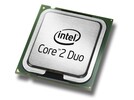Intel Core 2 Duo SL9400 vs Intel Core i5-470UM vs Intel Core 2 Duo T9600
Intel Core 2 Duo SL9400
► remove from comparison
Der Core 2 Duo SL9400 ist ein stromsparender Low Voltage Prozessor für dünne und leichte Notebooks. Er bietet den vollen 6MB Level 2 Cache des Penryn Kerns und bietet dadurch eine bessere Performance als andere 1.86 GHz Core 2 Duo Prozessoren mit weniger Cache (1-3MB üblich). Im Vergleich zum SL9380 bietet der SL9400 einen schnelleren FSB mit 1066 MHz.
Intel Core i5-470UM
► remove from comparisonDer Intel Core i5-470UM ist ein zwei-Kern Prozessor für sehr kleine und leichte Notebooks und taktet dank Turbo mit 1.3 - 1.87 GHz. Das U im Namen steht für Ultra Low Voltage und bezeichnet den geringen Stromverbrauch der CPU (sie wird mit einer geringen Spannung betrieben). Die zwei Kerne basiert auf die Nehalem (Westmere) Mikro-Architektur und können dank Hyperthreading 4 Threads gleichzeitig abarbeiten. Der 470UM positioniert sich zwischen i3-380UM (kein TurboBoost) und i-5 560UM (höherer Turbo bis 2 GHz und weitere Funktionen: AES, VT-d und Trusted Execution).
Eine Besonderheit der neuen Dual-Core CPUs von Intel ist die Integration des Speichercontrollers und einer integrierten Grafikkarte (GMA HD) in das Package. Die CPU wird bereits in 32nm hergestellt, der Die für den Speichercontroller und die Grafikkarte jedoch noch in 45nm.
Im Vergleich zu den anderen Dual Core Core i5 CPUs, bieten die UM-Modelle nur Anschluss für DDR3 800 Speicher (max 8 GB - Dual Channel).
Die Performance der einzelnen Kerne sollte dank Turbo, Hyperthreading und integrierten Speicherkontroller deutlich über denen eines gleichgetakteten Core 2 Duo mit 1.2 GHz liegen (die Recheneinheiten sind sonst ähnlich). Dadurch sollte der Core i5-470UM im Schnitt schneller als ein Core 2 Duo SU9400 (1.4 GHz) sein. Je nachdem wie gut das Kühlungssystem des Subnotebooks ist, kann auch der Turbo oft greifen und dadurch die Geschwindigkeit noch deutlich erhöhen.
Die integrierte Intel Graphics Media Accelerator HD (GMA HD) Grafikkarte wird mit 166-500 MHz getaktet werden (dank Turbo Boost). Durch den geringen Basistakt ist die Spieleleistung jedoch eventuell nicht sehr hoch (je nachdem ob der Turbo greifen kann oder nicht).
Der Stromverbrauch ist mit einem TDP von 17 Watt zwar relativ hoch für einen ULV Prozessor, jedoch ist darin die integrierte Grafikkarte und auch der Speichercontroller enthalten (vormals im Chipsatz welcher selbst 12 Watt benötigte). Dadurch ist der Stromverbrauch des ganzen Systems relativ gering. Durch den Turbo Mode wird der TDP unter Last jedoch (öfter) ausgereizt, wodurch der Stromverbrauch höher ausfallen kann als bei ähnlich spezifizierten Core 2 Duo Modellen.
Intel Core 2 Duo T9600
► remove from comparison
Die Intel Core 2 Duo T9600 Dual-Core CPU ist ein High-End Dual-Core Prozessor für Notebooks. Die Architektur des Prozessors basiert auf den Penryn Kern und wird in 45nm gefertigt. Im Vergleich zum schnelleren T9900 unterstützt er jedoch noch nicht den C1E State. Der neuere Core 2 Duo P9700 bietet die selben Leistungsdaten, jedoch bei deutlich geringerem Stromverbrauch (28 W versus 35 Watt TDP).
Dank der relativ hohen Taktung von 2.8 GHz, ist die Performance für die alle Spiele in 2009 ausreichend (nur GTA 4 profitiert deutlich von mehr Prozessorkernen). Die alten Core 2 Quad Mobilprozessoren (Q9000, QX9300) werden dank der hohen Taktung bei den meisten Spielen geschlagen (da Spiele aus 2009 meist nicht mehr als 2 Kerne auslasten).
Der Penryn (Montevina Update) Kern bietet 2 Integer Units, 1 Floating Point Unit, 1 Load Unit und 1 Store Unit in einer 14-stufigen Pipeline. Mit der Wide Dynamic Execution Technologie kann der Kern bis zu vier volle Instruktionen gleichzeitig ausführen.
Dank Dynamic Acceleration (später Turbo Modus genannt), kann sich ein Kern um eine Stufe übertakten, wenn der zweite im Idle Modus (Leerlauf) ist.
Das integrierte Enhanced Speedstep kann die Taktfrequenz des Prozessors dynamisch an die Leistungsanforderungen anpassen. Dadurch läuft die CPU ohne Last nur mit 800 MHz.
Der Core 2 Duo T9900 passt in den Socket P (mit 479 Pins):
Socket P / Micro Flip-Chip Pin Grid Array (Micro-FCPGA) requires 479-pin surface mount Zero Insertion Force (ZIF) socket (mPGA479M socket) or Micro Flip-Chip Ball Grid Array (Micro-FCBGA) for surface mount (479-ball)
| Model | Intel Core 2 Duo SL9400 | Intel Core i5-470UM | Intel Core 2 Duo T9600 | ||||||||||||||||||||||||||||||||||||||||||||||||||||
| Series | Intel Core 2 Duo | Intel Core i5 | Intel Core 2 Duo | ||||||||||||||||||||||||||||||||||||||||||||||||||||
| Codename | Penryn | Arrandale | Penryn | ||||||||||||||||||||||||||||||||||||||||||||||||||||
| Serie: Core 2 Duo Penryn |
| ||||||||||||||||||||||||||||||||||||||||||||||||||||||
| Clock | 1860 MHz | 1333 - 1867 MHz | 2800 MHz | ||||||||||||||||||||||||||||||||||||||||||||||||||||
| FSB | 1066 | 2500 | 1066 | ||||||||||||||||||||||||||||||||||||||||||||||||||||
| L2 Cache | 6 MB | 512 KB | 6 MB | ||||||||||||||||||||||||||||||||||||||||||||||||||||
| Cores / Threads | 2 / 2 | 2 / 4 | 2 / 2 | ||||||||||||||||||||||||||||||||||||||||||||||||||||
| TDP | 17 Watt | 18 Watt | 35 Watt | ||||||||||||||||||||||||||||||||||||||||||||||||||||
| Transistors | 410 Million | 382+177 Million | 410 Million | ||||||||||||||||||||||||||||||||||||||||||||||||||||
| Technology | 45 nm | 32 nm | 45 nm | ||||||||||||||||||||||||||||||||||||||||||||||||||||
| Voltage | 1.050V - 1.150V V | 1.05-1.2125 V V | |||||||||||||||||||||||||||||||||||||||||||||||||||||
| Die Size | 107 mm2 | 81+114 mm2 | 107 mm2 | ||||||||||||||||||||||||||||||||||||||||||||||||||||
| max. Temp. | 105 °C | 105 °C | |||||||||||||||||||||||||||||||||||||||||||||||||||||
| Socket | BGA956 | BGA1288 | Socket P (BGA479, PGA478) | ||||||||||||||||||||||||||||||||||||||||||||||||||||
| Features | Enhanced Speedstep, Intel VT, TXT | Intel HD Graphics 166-500MHz, DDR3-800 Memory Controller, Turbo Boost, Hyper-Threading, Virtualization Technology VT-x, Intel 64, Idle States, Enhanced Speedstep, Thermal Monitoring, Fast Memory Access, Flex Memory Access, Execute Disable Bit | |||||||||||||||||||||||||||||||||||||||||||||||||||||
| Architecture | x86 | x86 | x86 | ||||||||||||||||||||||||||||||||||||||||||||||||||||
| $284 U.S. | $316 U.S. | ||||||||||||||||||||||||||||||||||||||||||||||||||||||
| Announced | |||||||||||||||||||||||||||||||||||||||||||||||||||||||
| Manufacturer | ark.intel.com | ark.intel.com | ark.intel.com | ||||||||||||||||||||||||||||||||||||||||||||||||||||
| L3 Cache | 3 MB |


 Deutsch
Deutsch English
English Español
Español Français
Français Italiano
Italiano Nederlands
Nederlands Polski
Polski Português
Português Русский
Русский Türkçe
Türkçe Svenska
Svenska Chinese
Chinese Magyar
Magyar